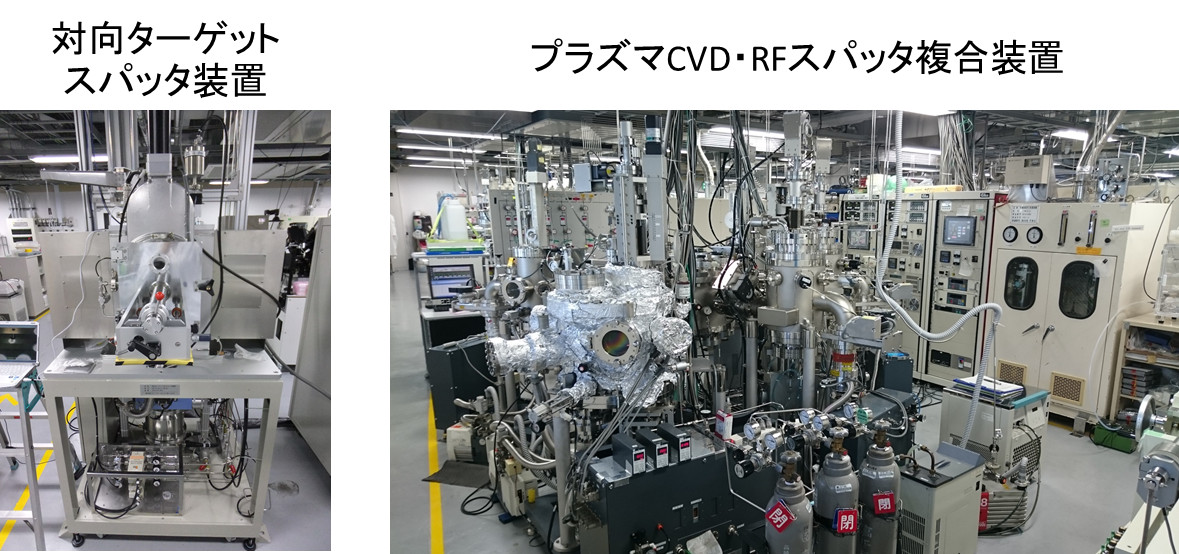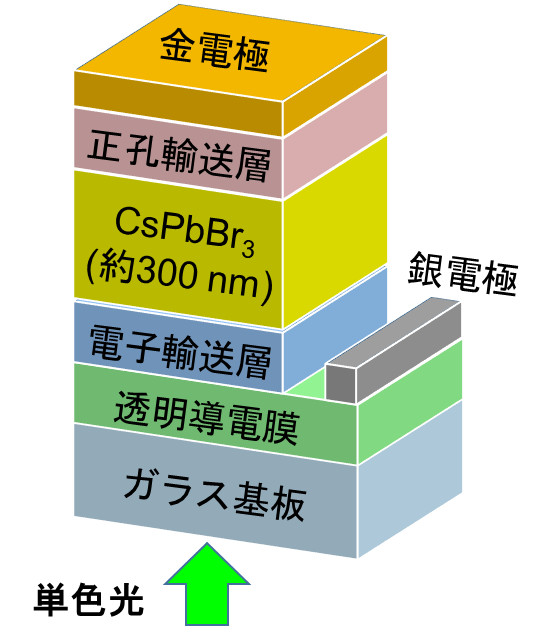Topics in Miyajima group
1. SiH4 free process for high efficiency SHJ solar cells
Recently, the installatin capacity of photovoltaic power generation system has increased rapidly. The growth of the installation capacity is driven by crystalline silicon solar cells, mainly polycrystalline silicon solar cells. With the spread of crystalline silicon solar cells, their manufacturing costs are falling significantly, and the ratio of solar cell manufacturing costs to photovoltaic power generation costs is falling rapidly. In such a situation, to reduce the cost of photovoltaic power generation, it is very important to improve efficiency as well as to reduce the manufacturing cost of solar cells. By increasing the generated power per area by increasing the conversion efficiency, it is possible to reduce the costs (such as BOS costs) other than solar cells. However, the manufacturing cost of high efficiency silicon solar cells is high. Therefore, our group investigate a potential technology to reduce the manufacturing cost of high efficiency solar cells. One of our approches is to employ soalr cell fabrication process without exprosive and toxic gases.(1)Deposition of high quality intrinsic a-Si:H passivation layer for silicon heterojunction solar cells
Very high efficienccy silicon solar cells usually employ heterojunctions using hydrogenated amorphous silicon (a-Si:H) instead of thermally diffused pn junction which is used in a standard silicon solar cells. This a-Si:H layers are deposited by plasma-enhanced or catalytic chemical vapor deposition. In these methods, monosilane (SiH4 which is very explosive gas is decomposed by plasma or heated metal wires and film formation occurs by reacting the radicals with the substrate surface. In addition p-type or n-type doping are carried out by adding small amount of B2H6 or PH3. It is well known that these doping gases are very toxic. Therefore, gas scrubbers and safety systems including leakage monitering systems and emergency scrubber systems are required to be installed. This increase the process costs.
To realize explosive and toxic gas free process (SiH4 free process), we focus on sputtering to. In sputtering process, an inert gas (typicall Ar) is ionized by plasma discharge. The generated Ar ions collide with a target which is a plate made of a material you would like to deposit. Some of the scattered atoms reach to a substrate and thin film is deposited. We can use a silicon target and a mixture of Ar and H2 (H2 concentration < 4%) to deposite a-Si:H by sputtering. However, sputtering processes are not used for depositing a-Si:H recently. One of the reason is the plasma damage to the substrate. To supress the plasma damage, we employ faceing target sputtering (FTS). We successfully depsoited high quality intrinsic a-Si:H passivation layer by using FTS and are trying to realize more better passivation quality.
Publication:
Shiratori et al., Applied Physics Express 11 031301 (2018)
Faris et al., Progress in Photovoltaics: Research and Applications 28 971 (2020)
Shiratori et al., IEEE Journal of Photovoltaics 10, 927 (2020)
Li et al., Solar RRL 8, 2400045 (2024)
(2)Fabrication Process of TOPCon Solar Cells by SiH4 Free Process
TOPCon solar cells have attracted attention in recent years as a high efficiency Si solar cell structure. However, the fabrication process requires the use of explosive and toxic gases such as SiH4 and PH3 to form amorphous silicon or polysilicon. We are now challenging to fabricate the TOPCon solar cell by using amorphous silicon deposited by facing target sputtering which is a SiH4-free deposition technique.
Publication:
Yamaguchi et al., Japanese Journal of Applied Physics 62 SK1024 (2023)
Experimental system
The picture shown below (left-hand side) is our faceing target sputtering (FTS) system which is used for depositing intrinsic a-Si:H passivation layer, metal oxide carrier selective layer, and transparent conductive oxide. The FTS system consists of a load-lock chamber and a main chamber. A FTS plasma source is installed on each three side walls of the main chamber. We also uses standard plasma-enhanced chemical vapor deposition (PECVD) system as a reference. This PECVD system consists of a load-lock chambeer, a chamber for lobotic arm for sample transfer, three PECVD chambers, and a RF-magnetron sputtering chamber. By using this PECVD system, p-type, n-type and intrinsic silicon based thin film materials (a-Si:H, hydrogenated microcrystalline siliocn), transparent conductive oxide (TCO), and metal oxide can be depsited.

2. Optial power converter for optical wireless power transmission
Wireless power transmission (WPT) techniques are very important for our future life. At present, WPT techniques are applied for battery charging of smart phones and small electronic appliances by using resonant inductive coupling method (Qi (standard)). This technique is very useful, but the distance of the power transmission is very limited. In addition, this technique cannot be used in the area in which electromagnetic interference is prohibited. To expand the application range of WPT techniques, it is important to develop a technique which can be applied for long-distance power transmission without electromagnetic interference. One of the promising candidates is Optical Wireless Power Transmission (OWPT).OWPT is energy transmission technique in which monochromatic light source (typically laser or LED) and optical power converter (typically a solar cell) is used. At present, the energy transmission efficiency of OWPT is relatively low (<50%). The energy transfer efficiency of OWPT is determined by the product of "electrical-to-optical energy conversion efficiency of the light source (wall plug efficiency)", "transmission efficiency between the light source and the optical power converter", and "optical-to-electrical energy conversion efficiency of the optical power converter". Miyajima group now investigates potential of optical power converters using widegap semiconductors in order to investigate the potential of OWPT.
(1)Development of high-quality widegap perovskite materials
A monochromatic light, laser or LED, is employed for the light source of optical wireless power transmission, therefore, optical power converter is required to be optimized to obtain maximum conversion efficiency for the monochromatic light. It is well known that the conversion efficiency of an optical pwoer converter strongly depends on the wavelength of the light source. An optical power converter can convert energy of light which has higher photon energy than the bandgap energy of the light absorbing layer in the optical power convereter into the electrical energy. When the photon energy of the light is much larger than the bandgap, excess energy (difference of the photon energy and the bandgap energy) is dissipated as thermal energy. Therefore, the maximum conversion efficiency of the optical power converter is obtained when the photon energy is close to the bandgap. When the photon energy which is very close to the bandgap is employed, theoretical conversion efficiency (perferct device structure and material quality) of an optical power converter is higher for higher bandgap. Therefore, an optical power converter using a widegap material (> 2.0 eV) is suitable for high efficiency optical power converter. (It is simultaneously important to develop high efficiency monochromatic light soure using a widegap material.). Miyajima group focuses on perovskite materials which have attracted much attention as light absorbing material for solar cells, and investigate optoelectronic properties of CsPbBr3.
(2)Optical power converter using widegap perovskite materials

The figure shown in the right-hand side illustrates a typical structure of our optical power converter using CsPbBr3 light absorbing layer. TiO2 and P3HT are normally used as an elecron transport layer and a hole transport layer. These materials are used in standard perovskite solar cells. We are now investigating new materials for the electron and hole transport layer which are more suitable for CsPbBr3 from the viewpoint of band lineup.
We fabricated the devices using TiO2 and P3HT and found that the devices showed photovoltaic propertiess so far. Especially, our previous study clearly indicates that careful adjustment of chemical composition of CsPbBr3 to reduce secondary phases is essential for high efficiency devices.
Publications:
Murata et al., AIP Adavnce 10, 045031 (2020)
Aso et al., Jpn. J. Appl. Phys. 62, SK1045 (2023)
Tan et al., Physica Status Solidi A 2400437, (2024)
Watanabe et al., Physica Status Solidi rrl 2500209 (2025)